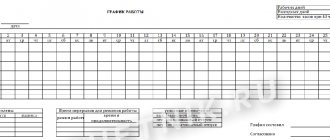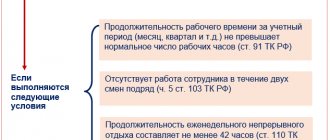The question will be of interest not only to personnel workers, but also to owners of their own organizations. Especially if you can’t do without organizing shift work for your subordinates. There are a lot of areas where shifts are practiced now. Any trade with a working day of 12 hours, services that imply round-the-clock operation of the company, etc. Therefore, it is necessary to hire workers so that they can work their shift and go on the weekend before the next shift. But how exactly should such a practice be formalized if it is understood that one cannot deviate from the rules for formalizing and consolidating the work regime?
What is a shift work schedule?
Important! Article 103 of the Labor Code of the Russian Federation states in black and white that a person cannot work two shifts in a row!
The same article of the Labor Code of the Russian Federation explains that a company can have a maximum of four shifts. Let us explain why shifts are needed in principle:
- To prevent employees from overworking.
- To ensure that the organization's equipment is used with maximum efficiency.
- To increase the output of goods.
When workers, or groups of workers, work in shifts, the firm can operate without stopping. But the schedule according to which people change must be approved in the form of a document. Moreover, the entire staff designated in this document must be familiarized with the schedule even before it comes into force. Moreover, in terms of time - at least 1 month.
Note: according to the labor code, the director of the company does not simply draw up a shift schedule and sign it. He is obliged to familiarize the workers with the document and ask their opinion (or the opinion of the trade union committee).
Question: The company has introduced a four-shift work schedule for personnel (shifts A, B, C, D)
At the request of an employee who worked on a day off or a non-working holiday, he may be given another day of rest. In this case, work on a weekend or a non-working holiday is paid in a single amount, and a day of rest is not subject to payment.
Specific amounts of payment for work on a day off or a non-working holiday may be established by a collective agreement, a local regulatory act adopted taking into account the opinion of the representative body of employees, or an employment contract.
How to compose
Here the compiler is given freedom of action, since there is no specialized form for compilation. The shift schedule is drawn up in free form, but must include the following mandatory positions:
- Shift duration
- Start of shift and end of shift
- Full name of employees related to the shift
- Features of scheduling shifts
Articles 91 and 104 of the Labor Code imply that any processing should be excluded. Accordingly, it is important for you, or your employee responsible for scheduling, to ensure that the employee is not more busy than indicated in the production calendar norm.
Make sure the timesheet is correct. It is impossible to allow not only general overtime for a period, but also for a day (Article 94 of the Labor Code).
But the employee’s uninterrupted rest must also be controlled - no more than forty-two hours in one week.
According to Article 95 of the same code, it follows that on the day followed by a holiday, a shift must be reduced by one hour.
Part-time employment
Part-time work is the performance of work that does not require the use of a person's entire working day.
An example of such work could be a highly skilled worker performing simpler work that does not require special education. Sub-items of part-time employment are: hidden unemployment and unintentional part-time employment. In case of hidden unemployment, the principle of seasonal work or provision of work for a while is applied. In this case, despite the fact that the person works, he does not receive any benefits provided by state law and cannot hope to continue working.
Unintentional part-time employment means working on a permanent basis, but without the opportunity to fully work out the working day. This situation arises due to a shortage of jobs; it is possible to simplify the work and hire someone else for part of the working time.
Enter the shift schedule
Preparation of the future shift work schedule is carried out in several stages. They will precede the schedule coming into effect.
- The first stage is to prepare a draft order, which reflects the specific start date of the shift schedule according to operating modes.
- The second stage is getting to know the employees’ schedule. It is necessary not only to show everyone the finished version, but also to obtain a signature from each employee involved in the schedule. Typically, this procedure is performed two months before the document on changing the schedule comes into force. This rule is regulated by Article 74 of the Labor Code of the Russian Federation.
- The third stage - you need to secure data about shifts and employees approved for them in a local act. This can be PVTR (internal labor regulations), or a collective agreement (collective labor agreement). This is a mandatory step!
- The fourth stage - the finished draft schedule, along with the order, must be sent to a representative of the labor collective, or to the trade union committee.
- The fifth stage is approval. This is done using an order, a sample of which can be easily downloaded on the Internet if this is your first time encountering this.
- The last stage is notification. We inform those involved in the changes to the new schedule that in one month the conditions will come into force (regulated by Article 103 of the Labor Code).
Important! After receiving consent to the established schedule, each employee will need to enter into an additional agreement to the employment contract stating that the working conditions will change.
If the employee disagrees, you need to offer him other employment. However, if there are no vacancies, you have the right to dismiss the worker in accordance with the seventh paragraph of the first part of Article 77 of the Labor Code.
I work on a four-shift continuous schedule.
By law, you are entitled to 14 paid vacation days for the first two years of work. However, four-shift jobs usually have collective agreements that may include an increased number of paid vacation days.
Special privileges for workers in four shifts are not provided for by law and may be the subject of collective agreements that apply at a particular production site. The law only provides that every six hours of work you are entitled to at least a half-hour break, and between each day of work the employee must rest for at least 8 hours.
How to get rid of overtime during a shift schedule
Typically, difficulties arise when drawing up a schedule, when it is assumed that the employee’s work schedule is based on the principle of a day every three days. If you are not careful, you can get this person overworked for up to 8 hours in one week, which naturally cannot be allowed.
In order to avoid this misfortune, try to find out the accounting period correctly. This is the period in which the standard for working hours is adopted (see any production calendar).
Moreover, according to the code, the accounting period should not be longer than a year, remember this.
Accounting period standards in 2021
- If there are 40 working hours per week, then during the accounting period there will be 1974 of them
- If the workweek consists of 36 hours, then the accounting period is 1776.4 hours.
- If the week is 24 hours, then the period is 1183.6 hours.
To explain everything clearly and simply, consider an example of calculating the number of employees for a forty-hour work week.
If one shift is equal to 24 hours, then the number of shifts in one year will be 82.25 (we divide the accounting period for the year at 1974 hours by 24 hours of one shift).
If you are thinking of hiring three or four workers per day, then everyone will work 91.25 shifts per year (365 days divided by 4 people). Accordingly, in hours it will be 2190 (let's multiply the number of shifts 91.25 by 24 hours per shift).
And since we already know that with forty hours a week, the accounting period should be 1974 hours per year, it turns out that the overtime of each of the four hired employees will be 216 hours (we subtract the accounting period of 1974 hours from the resulting 2190 hours).
It is important to understand here that even if you want to count these overtime hours as overtime, which is paid separately, you will not be able to do this thanks to Article 99 of the Labor Code of the Russian Federation. Because according to this article, overtime hours should not exceed 120 hours per year. And it turns out that the 96-hour overtime will still remain, which means you will break the law.
From this we conclude that for such a shift schedule we will have to hire no less than five people on staff.
Important! Before the schedule is drawn up, check the time standard for the year. It can change.
When should employees be informed about a change in working conditions?
The decision to transfer to a shift work schedule is not made quickly. To do this, the manager needs to prepare and go through a long bureaucratic path. Employees will also need to prepare for changing working conditions in the same way. Therefore, it is necessary to inform them of this news no later than a month before the introduction of the system. Each employee has the right to timely information about changes in working conditions, so the employer must comply and respect it.
How can a manager communicate changes to the schedule?
Methods of informing employees can be different: in the format of sending letters, transmitting messages through department heads, posting announcements at a stand. However, for their own protection, managers need to hedge their bets and create a system of “announcements against receipt.” In this case, the fact of familiarization with the new schedule must be recorded in writing in duplicate. One is stored in the archives of the personnel department, and the second is given to the employee.
What to do if an employee is not ready to work shifts?
The Labor Code of the Russian Federation provides for situations when an employee absolutely does not agree to new working conditions. The employer does not have the right to immediately dismiss him “without talking”: first, the employee must be offered another vacancy in accordance with his qualifications and state of health. You need to offer all vacancies that are open in the organization: in your locality in any case and, possibly, in remote regions, if this is provided for by the collective agreement or other agreements. If there is no such job, no vacancies are officially open, or the employee is not satisfied with any of the proposed options, then the employment contract is terminated.
Peculiarities
It often happens that a person cannot go on his shift due to illness (official sick leave). If the schedule is approved and signed, then you should not swap shifts. The one who missed his time leaves after the sick leave is closed exactly when his next shift is scheduled. And he doesn’t have to make up for what he missed.
When you count night shifts, always keep in mind that breaks are not included in the normal time limit! Accordingly, they will not be paid as nightly.
If the company employs an employee who has signed a fixed-term contract, be careful when drawing up the schedule. If it happens that the contract expires in the middle of a shift, and he continues to work further in this shift, then the contract with him automatically becomes permanent! (Reason - you gave permission to work after the end of the fixed-term contract). This is regulated by article number 58 of the Labor Code of the Russian Federation.
Systematization of accounting
Legislative framework The relationship between the employer and the employee is regulated by the Labor Code, including the preparation of shift work schedules, this issue is covered by Article 103. Since most often the shift work schedule obliges the employer to form small groups within structural units, a collective agreement is drawn up, where the interests are stated every employee.
- two days on a day shift from 08:00 to 16:00, then two days off (48 hours);
- two days in the evening shift from 16:00 to 24:00, then one day off (the so-called “transition” = 24 hours);
- two days on the night shift from 00:00 to 08:00, then three days off (one “sleep” + two days off = 72 hours).
Bottom line
As we can see, drawing up a shift schedule has many nuances that must be taken into account when drawing it up. This includes mandatory familiarization of the company’s employees, calculation of possible processing, and many other points, each of which is regulated by the labor code. Accordingly, it is better to spend a little more time than to commit violations that may later affect your activities in the form of fines. Moreover, after going through the procedure of drawing up and implementing a schedule several times, you will no longer consider that this is some kind of complex and intricate work. You just need to be a little attentive to details and calculations.
You may also be interested in the following material: “How to correctly fill out a work book”, “Working time sheet. Forms T-12, T-13.”
Four-shift operating mode is like
In any of these cases, the question arises of how to properly organize the payment of employees and keep track of working hours. The rules and features of payment, as well as possible problems, are worth considering in more detail.
Since the shift schedule is an annex (addition) to the collective agreement and directly affects the interests of employees, during its preparation the employer is obliged to take into account the position and opinion of the representative body of employees, which, as a rule, is a trade union organization. The procedure for reaching consensus between the employer and the representative body is established by Art. 372 Labor Code of the Russian Federation.
This is interesting: How many square meters are allocated per person in Belarus 2021 in the regional center
Is it necessary to familiarize employees with the vacation schedule?
When answering the question of whether it is necessary to familiarize employees with the vacation schedule, you should refer to Art. 123 Labor Code of the Russian Federation. This norm assigns the following imperative actions to the employer:
- accept the GO no later than 14 days before December 31;
- notify the employee in advance of the start date of his rest days;
- provide some groups of workers with leave at a time suitable for them.
GO is mandatory for both parties to the employment contract. Thus, an employee cannot voluntarily go on vacation without the consent of the employer; such an action can be qualified as absenteeism.
IMPORTANT! The exception is when a donor employee donates blood and is entitled to rest days, regardless of the employer’s consent. Absence from work for this reason is not regarded as absenteeism (clause 39 of the resolution of the Plenum of the Supreme Court of the Russian Federation dated March 17, 2004 No. 2).
Deadlines for reviewing the vacation schedule
The legislation establishes the minimum period for familiarization with the vacation schedule - 2 weeks before the start of the employee’s rest days (Article 123 of the Labor Code of the Russian Federation). There are no upper limits for this period.
Thus, the employee can be notified of the period of his vacation at any time from the moment the order is issued to approve the vacation schedule for the corresponding calendar year and 2 weeks before going on vacation (see the appeal ruling of the Samara Regional Court dated November 7, 2012 No. 33-10182 /2012).
More information about how civil defense is adopted is described in the article Order on approval of the vacation schedule - sample.
IMPORTANT! Failure by the employer to fulfill the obligation to timely notify the employee about the upcoming vacation gives the latter the opportunity to take a vacation at any other time suitable for him (Article 124 of the Labor Code of the Russian Federation).
Thus, the form of the sheet for familiarization with the vacation schedule is chosen by the employer at his own discretion. As a rule, it contains information about the employee and his rest period. The fact of familiarization with the specified period is certified by the employee’s handwritten signature.







